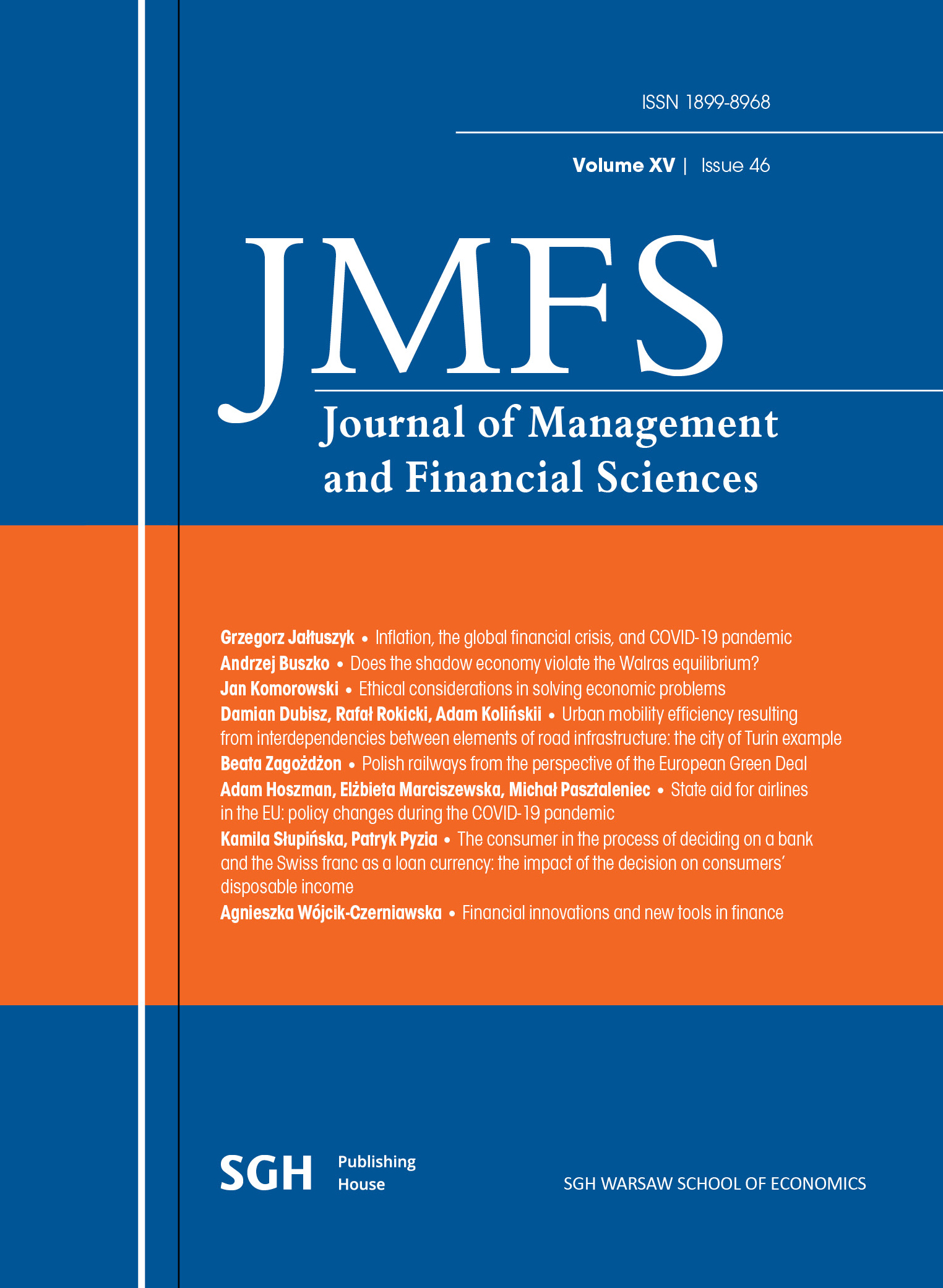Does the shadow economy violate the Walras equilibrium?
Main Article Content
Abstract
The paper is devoted to examining the role of the shadow economy in the context of market equilibrium. The Walras theorem was used in order to highlight the role of the shadow economy in market equilibrium violation. Habitually, a majority of theories as well as models focus just on observed variables and latent factors are omitted. The shadow economy is an unprejudiced typical case in this respect. It exists in any economy and it very often influences market mechanisms significantly. A mathematical model was employed to exhibit dependence between the shadow economy and market equilibrium. Whenever the shadow economy is ignored in modeling market equilibrium, the market is proved to be balanced. The situation changes when the shadow economy is taken into account. Market equilibrium is difficult to be achieved.
Downloads
Article Details

This work is licensed under a Creative Commons Attribution 4.0 International License.
References
Akerlof, G. (1970). The Market for Lemons: Qualitative Uncertainty and the Market Mechanism. Quarterly Journal of Economics, 84(3) pp. 488–500.
Arrow, K.J., Debreu, G. (1954). Existence of an equilibrium for a competitive economy. Econometrica, 22(3), pp. 265–290.
Blum, P., Galbraith, P.L., Henn, H., Niss, M. (Eds.) (2007). Modelling and applications in mathematics education: The 14th ICMI Study. New York: Springer.
Button, M., et al. (2014). Online Frauds: Learning from Victims Why They Fall for These Scams. Australian & New Zealand Journal of Criminology, 47, pp. 391–408.
Davar, E. (2005). Walras, L., Studies in Applied Economics Theory of the Production of Social Wealth. European Journal of Political Economy, 21, pp. 1016–1019.
Dastidar, K.G. (1995). On the existence of pure strategy Bertrand equilibrium. Economic Theory, 5, p. 17.
Giuliano, P., Ruiz-Arranz, M. (2009). Remittances, financial development and growth. Journal of Development Economy, 90(1), pp. 22–25.
Godfrey, P.C. (2011). Toward a theory of the informal economy. Academy of Management Annals, 5(1), pp. 31–33.
Gutmann, P. (1977). The Subterranean Economy. Financial Analysts Journal, 34(1), p. 12.
Hatipoglu, O., Ozbek, G. (2007). On the Political Economy of the Informal Sector and Income Redistribution. Working Papers 2007/11, Bogazici University, Department of Economics, p. 8.
Hicks, R. (1959). A “Value and Capital” Growth Model. Review of Economic Studies, Oxford University Press, 26(3), pp. 11–19.
Hicks, R. (1967). Critical Essays in Monetary Theory. Oxford: Clarendon Press.
Ihrig, J., Moe, K. (2004). Lurking in the shadows: The informal sector and government policy. Journal of Development Economics, 73, pp. 41–44.
Kawulich, B. (2009). The role of theory in the research. In: M. Garner, C. Wagner, B. Kawulich. Teaching Research Methods in the Social Sciences (pp. 37–38). Ashgate.
Karakoc, E. (2017, April). A theory of redistribution in new democracies: income disparities in new democracies in Europe. Comparative Politics, 49(3), p. 18.
Kreps, D. (1988). Notes on the theory of choice, underground classics in economics. Colorado: Westview Press, Inc. pp. 23–31.
Lackó, M. (1996). Hidden Economy – An Unknown Quantity? Comparative Analysis of Hidden Economies in Transition Countries in 1989–1995. Working Paper 9905, Economics Department, University of Linz, Austria, pp. 17–26.
Lange, O. (1942). Say’s Law: A Restatement and Criticism. In: Lange et al. (Eds.), Studies in Mathematical Economics and Econometrics. Cambridge: Cambridge University Press.
Lechner, G. (2019, June 24). Kondratieff Cycles and Monetary System. FH JOANNEUM University of Applied Sciences, p. 19.
Leijonhufvud, A. (1997). Models and theories. Journal of Economic Methodology, 4(2), pp. 22–24.
Lucas, R. (1977). Understanding business cycles. Carnegie-Rochester conference series on public policy, 5(1), p. 17.
Lumineau, F., Quelin, B. (2012). An empirical investigation of interorganizational opportunism and contracting mechanisms. Strategic Organization, 10, DOI: 10.1177/1476127011434798, p. 14.
Mares, I. (2003). The Politics of Social Risk: Business and Welfare State Development. Cambridge: Cambridge University Press, pp. 36–38.
McClelland, S.I., Fine, M. (2008). Embedded science: critical analysis of abstinence only evaluation research. Cultural Studies, Critical Methodologies, 8(1), pp. 50–81.
Menger, C. (2004). Principles of Economy. Ludwig von Mises Institute; electronic online edition [accessed: 25.02.2021], pp. 19.
North, D.C. (1990). Institutions, institutional change and economic performance. New York: Cambridge University Press, pp. 87–89.
Pareto, V. (1968). Mathematical Economics. In: W.J. Baumol, S.M. Goldfeld (Eds.), Precursors in Mathematical Economics: An Anthology. London: London School of Economics.
Pappa, E. (2009). The Effects of Fiscal Shocks on Employment and the Real Wage. International Economic Review, 50, p. 32.
Rosser, Jr, J.B., Rosser, M.V., Ahmed, E. (2000). Income inequality and the informal economy in transition economies. Journal of Comparative Economics, 28, p. 28.
Routledge, R. (2013). On the existence of coalition-proof Bertrand equilibrium. Economic Theory Bulletin, 1, p. 14.
Quarishi, S.Y. (2016, Nov 6). The Politics of Black Money. The decisive role money plays in polls is a catalyst for the rampant corruption and unchecked black money in the country. Business Today, p. 11.
Schneider, F., Klinglmair, R. (2004). Shadow Economies on the Rise Around the World. What do we know? Discussion Paper No. 1043. p. 21.
Schneider, F. (2015). Size and Development of the Shadow Economy of 31 European and 5 other OECD Countries from 2003 to 2015: Different Developments. Journal of Self – Governance and Management Economics, 3(4), p. 14.
Schumpeter, J.A. (1954), History of Economic Analysis. New York: Oxford University Press.
Seade, J. (1977). On the Shape of Optimal Tax Schedules. Journal of Public Economics, 7, p. 112.
Stiglitz, J. (2003, Winter/Spring). Challenging the Washington Consensus. The Brown Journal of World Affairs, IX (2), pp. 17–18.
Tanzi, V. (1983). The Underground Economy in the United States: Annual Estimates, 1930–80. IMF Staff Papers, 30(2), p. 28.
Veblen, Th. (2009). The theory of the leisure class. Oxford/New York: Oxford University Press, pp. 43–51.
Walras, L. (1954). Elements of Pure Economics. Translated by W. Jaffe. London: Allen and Unwin.
Williamson, J. (2007). Shock therapy and the Washington Consensus: a comment. Comparative Economic Studies, 49(1), p. 12.
Winkler, O. (2009). Interpreting Economic and Social Data. A Foundation of Descriptive Statistics. Berlin, Heidelberg: Springer Verlag, pp. 76–77.
Zierhut, M. (2020, Nov). Indeterminacy of Cournot – Walras equilibrium with incomplete markets. Economic Theory, 3, https://doi.org/10.1007/s00199-020-01248-2, pp.22–23
